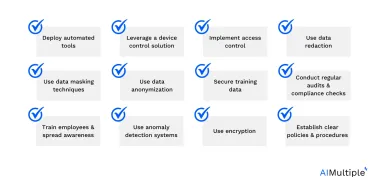Enterprises are investing in large language models (LLMs) and generative AI, making the protection of sensitive data used to train these AI systems essential. Recent statistics indicate a rise in LLM security concerns, highlighting the need for robust data loss prevention or DLP software and strategies.
We explore LLM DLP, providing insights and best practices to shield your business from data breaches and ensure compliance with data protection regulations.
What does DLP mean for LLMs?
At its core, LLM DLP involves a set of strategies and technologies designed to prevent unauthorized access and exposure of sensitive or confidential information within large language models. Given the vast amounts of data these models process, the risk of data leakage is not trivial. LLM DLP aims to mitigate these risks by enforcing stringent security measures around the data lifecycle.
Why do LLMs need data loss prevention?
Large language models are trained on extensive datasets that often contain proprietary information, trade secrets, and other forms of intellectual property. Without proper safeguards, this sensitive information can be inadvertently exposed, leading to significant financial and reputational damage. Moreover, compliance with data protection laws makes DLP not just a security measure but a legal imperative for businesses leveraging LLMs.
Real-world examples of LLM data breaches
Top 12 DLP best practices for LLMs
Implementing effective DLP for large language models requires a multifaceted approach. Below are some best practices specifically tailored for LLMs:
1. Deploy automated tools
Utilize AI-powered tools to monitor and manage data access dynamically. For instance, automated data loss prevention software can analyze patterns and behaviors in data usage, enabling proactive identification of potential data leakage and automated enforcement of data protection policies.
For ways to automate data loss prevention.
2. Leverage a device control solution
As more companies adopt a hybrid work model, it is important for them to monitor the devices being used at home. Device control solutions can assist in overseeing the security and compliance of remote devices, ensuring that sensitive data remains protected no matter where the work takes place.
Here is our guide to finding the right device control software.
3. Implement access control
Implement stringent access control measures to ensure that only authorized individuals have access to sensitive or confidential information. This includes:
- Managing API keys with precision
- Ensuring that they are not exposed in code or system logs
- Ensuring that they are regularly rotated to minimize risks.
You can also select a network access control solution for this list.
4. Use data redaction techniques
Data redaction is a technique used to prevent data leakage for LLMs. It involves selectively removing or obscuring sensitive or confidential information from the datasets used for training or inference in machine learning models. By redacting such information, organizations can prevent data leakage and ensure that sensitive details, such as personally identifiable information (PII) remain protected.
This method is particularly advantageous when working with LLMs, as it allows organizations to use valuable data while safeguarding sensitive information. Data redaction ensures that only necessary and non-sensitive information is accessible for model training and inference, thereby protecting the privacy and security of individuals and organizations involved.
Here are some data redaction techniques:
- Blacklisting: Removing or obscuring predefined sensitive terms or phrases, such as names, addresses, and credit card numbers, from the dataset.
- Attribute-based redaction: Identifying and redacting sensitive information based on specific attributes or metadata tags, ensuring that only non-sensitive information remains.
5. Use data masking techniques
When LLMs interact with personally identifiable information (PII) or sensitive data, employ data masking techniques to obscure confidential details. This ensures that even if data is accessed, the sensitive content is not exposed in its true form, thus protecting sensitive information while maintaining the utility of the data for training purposes.
Here is a list of some data masking techniques:
For test data management:
- Substitution: Replace original data with random data from a lookup file, maintaining the authentic look of data.
- Shuffling: Similar to substitution, it shuffles data within the same column for a realistic appearance.
- Number and date variance: Applies variance to financial and date-driven datasets to mask data without affecting accuracy, often used in synthetic data generation.
- Encryption: It uses complex algorithms to mask data, which is accessible only with a decryption key.
- Character scrambling: Randomly rearranges character order, making the process irreversible.
For sharing with unauthorized users:
- Nulling out or deletion: Replaces sensitive data with null values, simplifying the approach but reducing testing accuracy.
- Masking out: Masks only parts of the data, like hiding all but the last 4 digits of a credit card number, to prevent fraud.
6. Use data anonymization techniques
Data anonymization involves removing any information that could potentially identify an individual or organization from the datasets used to train machine learning models. This process helps prevent the exposure of sensitive information during both the training and inference phases of the model.
You can use the following techniques:
- Generalization: This technique involves replacing specific data points with more generalized values. For example, instead of using exact ages, ages can be grouped into ranges (e.g., “30-40 years old” instead of “34 years old”).
- Perturbation: This method adds noise to the data, altering the original values slightly while preserving overall trends and patterns. For example, numerical data can have random values added or subtracted within a certain range.
- Tokenization: Sensitive data elements are replaced with non-sensitive equivalents, often using random or pseudo-random tokens. For example, names, addresses, and other personal identifiers are replaced with unique but meaningless tokens that can be mapped back to the original values if needed.
7. Secure training data
The data used to train your own models should be treated with the utmost care. Ensure that all training data is stored securely, with encryption both at rest and in transit, and that access to this data is tightly controlled.
8. Conduct regular audits and compliance checks
Regularly audit your LLM interactions and data handling processes to ensure compliance with data protection regulations.
This process includes:
- Reviewing access logs: Analyzing records to track who has accessed the system and when
- Verifying the effectiveness of security measures: Assessing the robustness of implemented security protocols to protect against threats
- Ensuring data handling practices comply with legal and ethical standards: Confirming that the methods for managing data adhere to all relevant laws and ethical guidelines
9. Train employees & spread awareness
Educate your team about the importance of data security and the specific risks associated with LLMs. Regular training sessions can help employees understand their role in protecting sensitive information and the proper protocols to follow.
Here are the top mistakes that employees should avoid:
Figure 1. Common mistakes by employees contributing to cyber incidents worldwide3

10. Use anomaly detection systems
Implement systems capable of detecting unusual access patterns or unexpected data flows. Such anomalies can indicate potential security breaches or unauthorized attempts to access sensitive information.
Here is our guide to fraud and anomaly detection.
11. Use encryption
Encrypt sensitive or confidential information both in transit and at rest. Encryption acts as a critical barrier, ensuring that even if data is accessed by unauthorized individuals, it remains unintelligible and secure.
- Homomorphic encryption: Allows computations to be performed on encrypted data without decrypting it, offering a way to process sensitive information securely.
- Transport layer security (TLS): Ensures secure communication over a network, protecting the data exchanged between LLMs and clients from eavesdropping and tampering.
- Secure multi-party Computation (SMPC): Enables parties to jointly compute a function over their inputs while keeping those inputs private, suitable for collaborative LLM training with data privacy.
For more on data encryption.
12. Establish clear policies and procedures
Develop and maintain clear policies and procedures for handling sensitive data within your LLM ecosystem. This should cover everything from data collection and storage to processing and deletion, ensuring that every stage of the data lifecycle is secured.
FAQs for LLM DLP
-
What is DLP?
Data Loss Prevention (DLP) is a strategy and a set of tools used by organizations to ensure that sensitive or critical information does not leave the corporate network unauthorizedly or end up in the wrong hands. This involves monitoring, detecting, and blocking the transfer of sensitive data across the network and on devices, thereby safeguarding against data breaches, theft, or accidental loss. DLP solutions help in enforcing data security policies and compliance requirements, effectively mitigating the risk of data exposure.
Further reading
If you need further help in finding a vendor or have any questions, feel free to contact us:
External resources
- 1. OpenAI leaking custom chatbot data. Wired. Accessed: 18/March/2024.
- 2. OpenAI leaking private data. Markets&markets. Accessed: 18/March/2024.
- 3. Common mistakes by employees contributing to cyber incidents worldwide as of November 2022. Statista. Accessed: 15/March/2024.




Comments
Your email address will not be published. All fields are required.